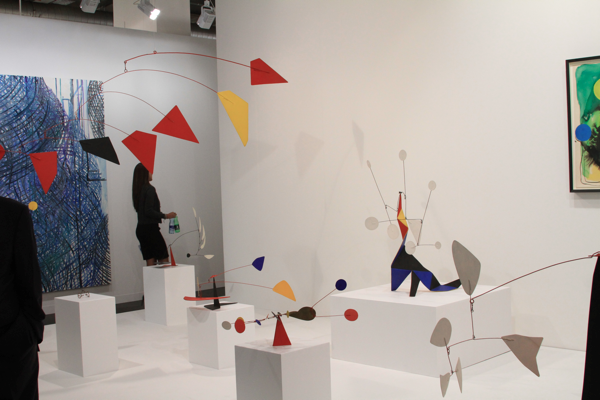Analysis
More, More, More . . . Art Basel Gets Bigger But Not Necessarily Better
European buyers abound at this megafair.

European buyers abound at this megafair.

Alexander Forbes

Scanning the Basel airport tarmac on Monday evening as Art Basel’s preview of the Unlimited section of the fair was already in full swing, the relatively low volume of private jets of the intercontinental variety, surprised. Likewise, while mobs of First Choice VIPs (the fair’s moniker for top-level attendees), scrambled to enter the Messe Basel’s Hall 2 as the clock struck 11 on Tuesday morning, it was giddy cries in French, Italian, German, and Spanish—not English—that could be heard.
Now in its second year with three editions—Miami, Hong Kong, and Basel—the Swiss megafair appears to be experiencing a touch of regionalism in its attendees. Several factors are certainly at work. The World Cup is drawing eyes of football club–owning megacollectors towards Brazil and away from Switzerland. The ever more mature Art Basel Hong Kong closed barely a month ago—something the group has rectified for 2015. And the increasing penetration and adoption of online platforms means that efficiency-driven collectors can approach fairs the way they do auctions: browsing before and phoning or emailing in their picks, or sending a proxy. Perhaps most important, by becoming more global, Art Basel has been able to increasingly tailor its individual fairs to suit the preferences of its three publics, meaning that American and Asian collectors may not feel the need to make the trip, while Europeans do.
Nonetheless, several people remembered the first hours of Tuesday’s preview as some of the most-packed they had seen the fair in years. And a typical cast of art world characters, were in attendance: Anita Zabludowicz, Beth DeWoody, Marty Margulies, Budi Tek, Richard Chang, Tico Mugrabi, and the Rubells (who only decided to make the trip at the last minute), among them. The more auction-centric hedge fund manager Steve Cohen was a surprise to see peeking in at Sprueth Magers’s booth, which features a particularly nice Cyprien Gaillard, before stopping at Xavier Hufkens’s booth next door to home in for a closer look at Roni Horn’s water-like glass sculpture Untitled (“The first thing I remember tasting and then wanting to taste again is the grayish-pink fuzz my grandmother skimmed from a spitting kettle of strawberry jam.”) (2013).
Of Art Basel’s 285 galleries in its 45th edition, Gagosian’s booth was most packed in the previews early hours—no surprise here. Nor was it a surprise that Tico Mugrabi, whose family holds the world’s largest Warhol collection, was eyeing a few works there by the Pop artist.
A slightly darkened side room off the booth offers a delightfully quiet contrast. It features a pair works each by Gerhard Richter and John Currin, an impressive Picasso and a slight Giacometti.

Helly Nahmad Gallery’s booth at Art Basel 2014
Photo: © artnet News.
Nearby, at Helly Nahmad, crowds swarmed an impressive of nearly 10 mobiles and sculptures by Alexander Calder. The dealer is likely taking cues from his $12 million sale of the artist’s Sumac (1961) and further success for the artist at this year’s TEFAF. Prices on the smaller works were overheard to be in the range from $1.35 to $3 million.
Across the fair, Lee Ufan is remarkably well represented. The Korean minimalist painter was tapped by Versailles for their 2014 show, which opened last week and which was feted by a cackle of prominent guests just nights before Art Basel’s preview. The artist is having a major moment with collectors as well, having recorded his third and fourth highest prices at auction—both in the realm of $1.6 million) during May’s Hong Kong auctions. At Pace, Ufan’s paintings and a sculpture from between 1978 and 2008, were topping up at $2 million.
Picking up on Klaus Biesenbach and Hans Ulrich Obrist’s performance-centric, faux-institutional show, 14 Rooms, live art proves a notable highlight on Art Basel’s second floor. At Air de Paris’s booth, Jef Geys has plopped an American football player, posing and attempting to throw a lateral to passers by, in front of a pair of canvases. Just behind, in the newly relocated Statement’s section, PSM debuts a performance by Danish artist Christian Falsnaes, Justified Beliefs. In it, two actors don headphones into which a two-hour loop of 23 different commands is piped. Two other sets are left out for bystanders to join in. Bystanders, which, thanks to that move from Hall 1 next to Unlimited and the subtraction of 10 galleries from the section, were aplenty. PSM owner Sabine Schmidt, who had previously participated in the section in 2011, praised the move. She said, “It’s great to be in a more sales-oriented environment.”
Marlborough London’s 24-hour security guard standing watch over a smattering of high-level work is an unintended performance in its own right. Principle among those was Joan Miró’s Peinture (1953) and yet another Picasso both of which were rumored to be priced north of $20 million. “It’s been very exciting,” newly appointed director Alex Platon remarked.